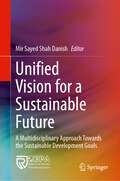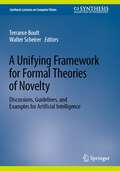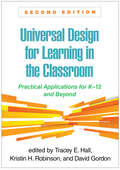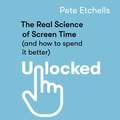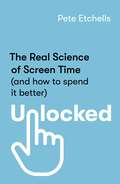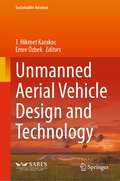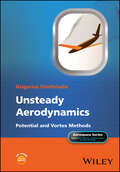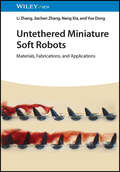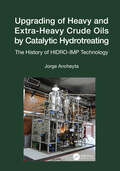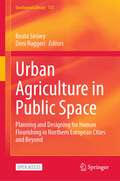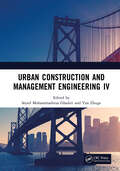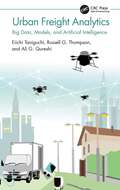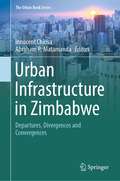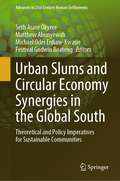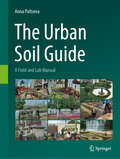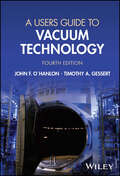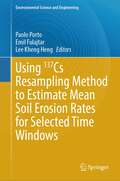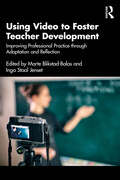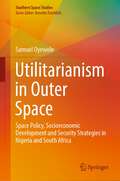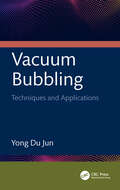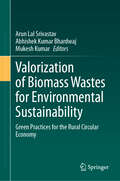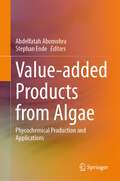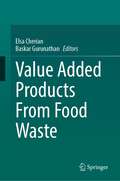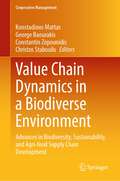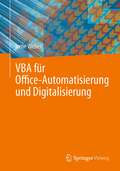- Table View
- List View
Unified Vision for a Sustainable Future: A Multidisciplinary Approach Towards the Sustainable Development Goals
by Mir Sayed Shah DanishUnified Vision for a Sustainable Future: A Multidisciplinary Approach Towards the Sustainable Development Goals focuses on energy and the environment, highlighting interdisciplinary research, innovative strategies, and global initiatives presented at the International Conference on Collaborative Endeavors for Global Sustainability (CEGS 2024). The book explores the various pillars of sustainability – environmental, social, institutional, technical, and economic – and provides readers with case studies, practical solutions, and models for the UN’s Sustainable Development Goals. The book further examines the implications of these initiatives, analyzing their potential for long-lasting, sustainable impact.This book will appeal to a broad readership. Academics, researchers, policymakers, sustainability advocates, and anyone interested in global sustainability will find the book insightful.
A Unifying Framework for Formal Theories of Novelty: Discussions, Guidelines, and Examples for Artificial Intelligence (Synthesis Lectures on Computer Vision)
by Terrance Boult Walter ScheirerThis book presents the first unified formalization for defining novelty across the span of machine learning, symbolic-reasoning, and control and planning-based systems. Dealing with novelty, things not previously seen by a system, is a critical issue for building vision-systems and general intelligent systems. The book presents examples of using this framework to define and evaluate in multiple domains including image recognition image-based open world learning, hand-writing and author analysis, CartPole Control, Image Captioning, and Monopoly. Chapters are written by well-known contributors to this new and emerging field. In addition, examples are provided from multiple areas, such as machine-learning based control problems, symbolic reasoning, and multi-player games.
Universal Design for Learning in the Classroom: Practical Applications for K-12 and Beyond
by Tracey E. Hall Kristin H. Robinson David GordonThe Universal Design for Learning (UDL) framework has grown from its origins in special education to being widely used to support all students, making the fully rewritten second edition of this indispensable guide more relevant than ever. Filled with practical, vivid examples and tips, the book demonstrates the power of UDL when applied to particular content areas. Specific teaching ideas are presented for literacy, STEM, project-based learning, career and technical education, and the arts. The editors and contributors describe practical ways to create thriving learning environments that use UDL to meet diverse learners' needs. New to This Edition *Entirely new content. *Coverage expanded from elementary and middle grades to secondary and beyond. *Innovative approaches embracing the growth of UDL and the ubiquity of digital technologies in today&’s classrooms. *Spotlight on issues of equity and inclusion. *Chapters on antiracism, social–emotional learning, career and technical education, journey mapping, and curriculum design. *Compelling discussions of advances in UDL principles and research directions.
Unlocked: The Real Science of Screen Time (and how to spend it better)
by Pete Etchells'A welcome counterpoint to the technopanic that screen time is causing a mental health crisis' Bruce Hood 'A rare mix of trustworthy science, practical advice, and human stories ... I'm going to recommend it to all the parents I know, and keep it handy for reference next time I see a scary headline about how technology is ruining our lives' Timandra HarknessMost of us spend a significant part of the day in front of a screen. Our work and social lives play out through our computers, tablets and phones: on email, social media, video conference calls and gaming servers. But what is all this screen time doing to our health, our sleep, and our relationships?Professor Pete Etchells studies the way we use screens, and how they can affect us. In UNLOCKED, he delves into the real science behind the panic about our alleged device addiction and withering attention spans. Armed with the latest research, he reveals how little we have to fear, and the great deal we have to gain, by establishing a more positive relationship with our screens. That begins with asking ourselves some essential questions about how we use them.Instead of clamouring for us to ditch our devices (before guiltily returning to the same old habits), UNLOCKED is a sustainable, realistic and vital guide to transforming our connection with technology.
Unlocked: The Real Science of Screen Time (and how to spend it better)
by Pete Etchells'A welcome counterpoint to the technopanic that screen time is causing a mental health crisis' Bruce Hood 'A rare mix of trustworthy science, practical advice, and human stories ... I'm going to recommend it to all the parents I know, and keep it handy for reference next time I see a scary headline about how technology is ruining our lives' Timandra HarknessMost of us spend a significant part of the day in front of a screen. Our work and social lives play out through our computers, tablets and phones: on email, social media, video conference calls and gaming servers. But what is all this screen time doing to our health, our sleep, and our relationships?Professor Pete Etchells studies the way we use screens, and how they can affect us. In UNLOCKED, he delves into the real science behind the panic about our alleged device addiction and withering attention spans. Armed with the latest research, he reveals how little we have to fear, and the great deal we have to gain, by establishing a more positive relationship with our screens. That begins with asking ourselves some essential questions about how we use them.Instead of clamouring for us to ditch our devices (before guiltily returning to the same old habits), UNLOCKED is a sustainable, realistic and vital guide to transforming our connection with technology.
Unmanned Aerial Vehicle Design and Technology (Sustainable Aviation)
by T. Hikmet Karakoc Emre ÖzbekUnmanned Aerial Vehicle Design and Technology provides readers with a comprehensive introduction to unmanned aerial systems (UAS) technology basics. The book presents clear, concise guidance on UAS system design, components, control, and operations fundamentals. Additional chapters look at unmanned aerial regulations and ethics and the historical background of UAS technology. This textbook offers a well-rounded look at unmanned flight technology, making it an ideal primer for aviation and aerospace students and anyone interested in learning more about unmanned aerial systems, including engineers, technicians, drone and flight hobbyists, and civil aviation organization officials.
Unsteady Aerodynamics: Potential and Vortex Methods (Aerospace Series)
by Grigorios DimitriadisUnsteady Aerodynamics A comprehensive overview of unsteady aerodynamics and its applications The study of unsteady aerodynamics goes back a century and has only become more significant as aircraft become increasingly sophisticated, fly faster, and their structures are lighter and more flexible. Progress in the understanding of flow physics, computing power and techniques, and modelling technologies has led to corresponding progress in unsteady aerodynamics, with a wide range of methods currently used to predict the performance of engineering structures under unsteady conditions. Unsteady Aerodynamics offers a comprehensive and systematic overview of the application of potential and vortex methods to the subject. Beginning with an introduction to the fundamentals of unsteady flow, it then discusses the modelling of attached and separated, incompressible and compressible flows around two-dimensional and three-dimensional bodies. The result is an essential resource for design and simulation in aerospace engineering. Unsteady Aerodynamics readers will also find: MATLAB examples and exercises throughout, with codes and solutions on an accompanying website Detailed discussion of most classes of unsteady phenomena, including flapping flight, transonic flow, dynamic stall, flow around bluff bodies and more Validation of theoretical and numerical predictions using comparisons to experimental data from the literature Unsteady Aerodynamics is ideal for researchers, engineers, and advanced students in aerospace engineering.
Untethered Miniature Soft Robots: Materials, Fabrications, and Applications
by Li Zhang Jiachen Zhang Neng Xia Yue DongUntethered Miniature Soft Robots Reference on achieving contactless manipulation of soft robots, detailing high level concepts and perspectives and technical skills of soft robots Untethered Miniature Soft Robots: Materials, Fabrications, and Applications introduces the emerging field of miniature soft robots and summarizes the recent rapid development in the field to date, describing different types of functional materials to build miniature soft robots, such as silicone elastomer, carbon-based materials, hydrogels, liquid crystal polymer, flexible ferrofluid, and liquid metal, and covering the material properties, fabrication strategies, and functionalities in soft robots together with their underlying mechanisms. The book discusses magnetically, thermally, optically, and chemically actuated soft robots in depth, explores the many specific applications of miniature soft robots in biomedical, environmental, and electrical fields and summarizes the development of miniature soft robots based on soft matter, fabrication strategies, locomotion principles, sensing and actuation mechanisms. In closing, the text summarizes the opportunities and challenges faced by miniature soft robots, providing expert insight into the possible futures of this field. Written by four highly qualified academics, Untethered Miniature Soft Robots covers sample topics such as: Soft elastomer-based robots with programmable magnetization profiles and untethered soft robots based on template-aiding Working mechanisms of carbon-based materials, covering light-induced expansion and shrinkage, and humidity-induced deformation Designing microscale building blocks, modular assembly of building blocks based on Denavit-Hartenberg (DH) matrix, and inverse and forward design of modular morphing systems Material designs of magnetic liquid crystal elastomers (LCE) systems, multiple-stimuli responsiveness of magnetic LCE systems, and adaptive locomotion of magnetic LCE-based robots Controllable deformation and motion behaviors, as well as applications of ferrofluids droplet robots (FDRs), including cargo capturing, object sorting, liquid pumping/mixing, and liquid skin. Providing highly detailed and up-to-date coverage of the topic, Untethered Miniature Soft Robots serves as an invaluable and highly comprehensive reference for researchers working in this promising field across a variety of disciplines, including materials scientists, mechanical and electronics engineers, polymer chemists, and biochemists.
Upgrading of Heavy and Extra-Heavy Crude Oils by Catalytic Hydrotreating: The History of HIDRO-IMP Technology
by Jorge AncheytaThis book explores the common approaches to upgrade heavy and extra-heavy crude oils by means of catalytic hydrotreating, emphasizing hydrogen addition technology as well as carbon rejection alternatives. Kinetic and reactor models are combined with experimental data to simulate and optimize commercial-scale reactor performance. Key Features• Focuses on fixed-bed catalytic hydrotreating and catalysts and process scheme characteristics for commercial application.• Guides readers on hydrotreating process technology development from batch reactor experiments to semi-commercial test.• Describes step-by-step methodologies for development of kinetic models based on experimental data generated at different reaction scales.• Provides detailed explanation on how to formulate a reactor model for the simulation of catalytic hydrotreating of heavy oils. A comprehensive guide to the upgrading of crude oils, this book has particular appeal for petroleum refining industry professionals, catalyst developers, workshop instructors, professors, and their graduate and postgraduate students.
Urban Agriculture in Public Space: Planning and Designing for Human Flourishing in Northern European Cities and Beyond (GeoJournal Library #132)
by Deni Ruggeri Beata SirowyThis open access book discusses urban agriculture initiatives integrated in public space of dense inner-city neighbourhoods, thereby ensuring its accessibility for large and diverse segments of urban populations. It specifically focuses on the potential impacts of urban agriculture on human well-being (both on individual and community levels), and how planning, design, policy and management practices can maximize these impacts. The book addresses urban agriculture on both a micro and macro scale to facilitate a transition to more sustainable lifestyles and enhance the quality of urban life. It also discusses ways to permanently integrate urban agriculture in existing and planned public spaces in a visually attractive, socially inclusive, and democratic manner to claim and reclaim the right to the city. Based on the research outcomes of the project “Cultivating Public Space: urban agriculture as a basis for human flourishing and sustainability transition in Norwegian cities” funded by the Research Council of Norway, the book emerges from a Norwegian context, but extends to include international urban agriculture cases from the Netherlands, Denmark, the UK and more. By including a diversity of voices and cultural perspectives, the editors aimed to make this book engaging and relevant to an international audience of researchers, policy makers, urban designers, planners, educators, community activists, residents, and public space users of the sustainable, compact city of today and the future.
Urban Construction and Management Engineering IV
by Seyed Mohammadreza Ghadiri Zhuge YanUrban Construction and Management Engineering IV focuses on the research of construction technology and the engineering management in urban construction. This proceedings gathers the most cutting-edge research and achievements, and will provide scholars and engineers with preferable research directions and engineering solutions as reference. Subjects in this proceedings include: Civil Engineering Engineering Structure Engineering Management Low Carbon City Urban Management The works of this proceedings encourages development of civil engineering and construction technology. Thereby, the work promotes scientific information interchange between scholars from the top universities, research centers and high-tech enterprises working all around the world.
Urban Freight Analytics: Big Data, Models, and Artificial Intelligence
by Eiichi Taniguchi Russell G. Thompson Ali G. QureshiUrban Freight Analytics examines the key concepts associated with the development and application of decision support tools for evaluating and implementing city logistics solutions. New analytical methods are required for effectively planning and operating emerging technologies including the Internet of Things (IoT), Information and Communication Technologies (ICT), and Intelligent Transport Systems (ITS). The book provides a comprehensive study of modelling and evaluation approaches to urban freight transport. It includes case studies from Japan, the US, Europe, and Australia that illustrate the experiences of cities that have already implemented city logistics, including analytical methods that address the complex issues associated with adopting advanced technologies such as autonomous vehicles and drones in urban freight transport. Also considered are future directions in urban freight analytics, including hyperconnected city logistics based on the Physical Internet (PI), digital twins, gamification, and emerging technologies such as connected and autonomous vehicles in urban areas. An integrated modelling platform is described that considers multiple stakeholders or agents, including emerging organisations such as PI companies and entities such as crowd-shippers as well as traditional stakeholders such as shippers, receivers, carriers, administrators, and residents. This book Presents procedures for evaluating city logistics technologies and policy measures Provides an overview of advanced modelling approaches, including agent-based model and machine learning Highlights the essential features of optimisation and simulation models applied to city logistics Discusses how models incorporating more uncertainty and dynamic data can be used to improve the sustainability and resilience of urban freight systems The book is ideal for graduate students in civil and environmental engineering and logistics management, urban planners, transport engineers, and logistics specialists.
Urban Infrastructure in Zimbabwe: Departures, Divergences and Convergences (The Urban Book Series)
by Innocent Chirisa Abraham R. MatamandaThe book provides insights into urban infrastructure debates and discourses in Zimbabwe. Through an inter-disciplinary and multi-disciplinary approach, the book explores the theoretical, conceptual and lived experiences in urban infrastructure. The book focuses on case studies relating to urban transport, public housing, water and sanitation and Geographical Information Systems (GIS) among other substantive issues relating to urban infrastructure and services.
Urban Slums and Circular Economy Synergies in the Global South: Theoretical and Policy Imperatives for Sustainable Communities (Advances in 21st Century Human Settlements)
by Seth Asare Okyere Matthew Abunyewah Michael Odei Erdiaw-Kwasie Festival Godwin BoatengThis book takes a theoretical and empirical distance from urban slums/low-income settlements as a threat to environmental sustainability and recast them as places where environmentally rehabilitative and circular practices occur—drawing on the theoretical lens of the circular economy (CE). CE is defined as regenerative system that minimizes waste, emission, and energy leakage by slowing, closing, and narrowing material and energy loops. In principle, CE departs from the traditional linear model of take-make-use-dispose. As conceived in urban contexts, circular cities offer possibilities to regenerate natural systems, design out waste, and keep products in use. While the CE key principles of reduce, repair, and reuse are essential to the sustainable and inclusive interventions in urban slums, there is lack of case studies exploring the role of place and agency, especially the slum living-CE nexus in global south contexts. In inequitable urban transitions, a nuanced understanding of thesynergies between urban slums and the circular economy is not only theoretically relevant for reconceptualizing the slum in urban sustainability discourses but also exert policy and practice ramifications to decidedly figure out how the urban slum phenomenon can foster the sustainable and inclusive development of marginal areas through contextual and people-centered initiatives.
The Urban Soil Guide: A Field and Lab Manual
by Anna PaltsevaDelve into the fascinating world of soil science with "The Urban Soil Guide," a comprehensive manual designed for everyone from science beginners to seasoned horticulturists. Whether you're an introductory science student, a passionate gardener, a landscape designer, or a professional horticulturist, this guide is tailored for you. Packed with a variety of hands-on activities, this guide makes learning soil science both accessible and enjoyable. From simple experiments that can be performed in your kitchen to more advanced techniques, it offers a practical approach to understanding soil. Written by a soil scientist, this guide bridges the gap between professional knowledge and amateur enthusiasm. The Urban Soil Guide is versatile enough to serve as a textbook in botanical gardens and university classes, while also being an invaluable resource for amateurs. Choose activities that match your interest and level of expertise. Embark on your journey to becoming a soil expert with The Urban Soil Guide – your hands-on companion in the world of soil science.
A Users Guide to Vacuum Technology
by John F. O'Hanlon Timothy A. GessertA USERS GUIDE TO VACUUM TECHNOLOGY Choose and understand the vacuum technology that fits your project’s needs with this indispensable guide Vacuum technology is used to provide process environments for other kinds of engineering technology, making it an unsung cornerstone of hundreds of projects incorporating analysis, research and development, manufacturing, and more. Since it is very often a secondary technology, users primarily interested in processes incorporating it will frequently only encounter vacuum technology when purchasing or troubleshooting. There is an urgent need for a guide to vacuum technology made with these users in mind. For decades, A User’s Guide to Vacuum Technology has met this need, with a user-focused introduction to vacuum technology as it is incorporated into semiconductor, optics, solar sell, and other engineering processes. With an emphasis on otherwise neglected subjects and on accessibility to the secondary user of vacuum technology, it balances treatment of older systems that are still in use with a survey of the latest cutting-edge technologies. The result promises to continue as the essential guide to vacuum systems. Readers of the fourth edition of A User’s Guide to Vacuum Technology will also find: Expanded treatment of gauges, pumps, materials, systems, and best??operating practices Detailed discussion of cutting-edge topics like ultraclean vacuum and contamination control An authorial team with decades of combined research and engineering experience A User’s Guide to Vacuum Technology is essential for those entering emerging STEM programs, engineering professionals and graduate students working with a huge range of engineering technologies.
Using 137Cs Resampling Method to Estimate Mean Soil Erosion Rates for Selected Time Windows (Environmental Science and Engineering)
by Paolo Porto Emil Fulajtar Lee Kheng HengThis book provides guidelines for using a new approach of resampling the Cs-137 radionuclide tracer which is used to estimate soil erosion rates. The Cs-137 resampling approach will improve significantly the use of the Cs-137 method for assessment of soil erosion, because resampling the radionuclide repeatedly (at least two times, but more sampling campaigns are possible) allows to avoid several methodological difficulties associated with Cs-137 method, namely the problems with small-scale spatial heterogeneity, the question of representativeness of reference site, reference samples, and inappropriate time extent of evaluated period. All these methodological problems are very important for reliability and accuracy of erosion rates estimated by Cs-137 method. If using single sampling approach, the small-scale spatial heterogeneity can be overcome by high number of sampling points, but this is time and labour demanding solution increasing the expenses of the erosion research. The representativeness of reference site is evaluated usually on the basis of expert judgement and knowledge of land use history of studied area, but this approach is often uncertain because the expert judgement can be subjective and the data on land use history is often not sufficient. Further, in many areas an appropriate reference site is not available, what limits the territorial extent of using Cs-137 method. The resampling approach offers its second sampling to be done in a proximate vicinity of the same points sampled during the first sampling campaign. A great advantage is the possibility to decide how long time windows should be investigated. Choosing the time schedule of first and second sampling allows to shorten the time window and adjust it to the study objectives. This is a great improvement of the Cs-137 method, because the time period since the Cs-137 fallout is still growing and thus if using the single sampling approach the results refer to still longer and longer time window(since the Cs-137 fallout until the sampling time), and this period (recently ca 60 years assuming the maximum Cs-137 fallout in 1963) is too long to represent stable land use, because land uses are changing over the time and having the same land use over six decades is rather rare. The improvement of Cs-137 method achieved by resampling approach is significantly contributing to understanding the erosion dynamics and estimating its rates under changing environmental conditions (such as land uses, weather), and it will bring a significant benefit to soil conservation programmes, because Cs-137 method is indispensable for assessing the medium and long term soil erosion rates, and this information is among the basic inputs needed for planning and designing soil conservation measures.
Using Video to Foster Teacher Development: Improving Professional Practice through Adaptation and Reflection
by Marte Blikstad-Balas Inga Staal JensetFeaturing an international team of education researchers and practitioners, this edited volume demonstrates various ways in which the use of video recordings can shed light on and improve teaching processes in the classroom environment.Providing a novel and global approach to this burgeoning area of research, chapters highlight how authentic video clips can be used systematically in both teacher education and professional development programs to ensure lifelong professional reflection and growth for teachers. Through detailed insight into research projects where teachers and teacher educators use video to improve practice, the book provides a research-based response to why and how videos can be used to raise instructional quality and discuss key issues in the field.Exploring findings from empirically based research combined with everyday practices, the volume will ultimately serve as a solid and inspiring introduction to the growing body of research on the use of video in teacher learning for educational researchers and educators interested in teaching and teaching practices, as well as practitioners in the fields of teacher education and teachers’ professional development.
Utilitarianism in Outer Space: Space Policy, Socioeconomic Development and Security Strategies in Nigeria and South Africa (Southern Space Studies)
by Samuel OyewoleThis book showcases Nigerian and South African experiences on space politics, policy and strategy vis-à-vis their development and security aspirations, while contributing to the broader African and the Global-South perspectives on the subject. Space policy in developing countries such as Nigeria and South Africa is motivated by utilitarian promises that space and the attendant technologies have the potential to advance development and security interests of the affected nations. However, several decades into the orbital journey of these countries, little is known of their space politics, policies, strategies, capacities and capabilities, and realisation of desired objectives. Beyond pure and applied sciences reductionism, this book offers social science perspectives on space studies in Africa, as it examines the intricate relationships of historical, geographical, social, demographic, economic, political, administrative, and strategic factors, nationally, regionally and globally that have shaped research and development of space science and technologies, and their benefits, in Nigeria and South Africa.
Vacuum Bubbling: Techniques and Applications
by Yong Du JunVacuum Bubbling introduces the background and applications for generating bubbles under a vacuum condition, accomplished through depressurization without the need to heat water. It presents the advantage of utilizing vapor bubble in deaeration applications because the diffusion for degassing happens between the water body and micro vapor bubbles without the need of membrane or packing.Instead of relying on massive heating, vacuum bubbling focuses on depressurization down to the level of saturated vapor pressure or below to secure vapor bubbles with virtually zero dissolved non-condensable gases, including oxygen. The book considers prospective applications, such as extracting high-oxygen-content air from water for underwater breathing, pretreatment of aircraft fuel before being pumped into a fuel tank system, and probable desalination applications through massive bubbling combined with low-grade renewable energy.The book is intended for researchers in thermal fluids, heat and mass transfer, process engineering, and water treatment fields and industry professionals working in power generation, plant and process engineering, transportation, and energy.
Valorization of Biomass Wastes for Environmental Sustainability: Green Practices for the Rural Circular Economy
by Mukesh Kumar Arun Lal Srivastav Abhishek Kumar BhardwajThis volume discusses the reduction, recycling, and reuse of industrial and agricultural biomass wastes to develop value-added products using environmentally sustainable practices and technologies. Through these waste valorization approaches, biomass waste materials can be converted into useful bio-chemical products, sustainable construction materials, polymers, bio-energy, and bio-fuel as sustainable alternatives to products and materials with negative environmental and health consequences. The chapters highlight the development and implementation of eco-friendly solutions to biomass waste production with the aim of reducing natural resource deterioration, bolstering rural and small-scale business systems in communities impacted by pollution and climate change, and providing power from residual biomass to broadly reduce environmental impacts through improved waste management practices. The book is intended to be a useful resource for researchers, policymakers, NGOs, government agencies, and local community authorities working in waste management and environmental sustainability.
Value-added Products from Algae: Phycochemical Production and Applications
by Abdelfatah Abomohra Stephan EndeThis book provides a comprehensive overview of value-added products from algae, presenting the fundamentals of algal cultivation, metabolism, harvest, and cellular pathways of phycochemicals biosynthesis. It offers sufficient details for both experts and non-experts to grasp the recent progress in this field. The book also discusses new phycochemicals and advancements in technology development, from separation to scale-up commercialization. Divided into 18 chapters, the book begins with an introduction to the value of algae as a renewable resource, followed by an authoritative overview of topics such as algae cultivation systems, harvesting techniques, phycochemical analysis, artificial intelligence in phytochemical recognition, and bioprocess engineering. Additional chapters cover various aspects of algal biotechnology, including biorefinery technology, biofuel-integrated routes, and the use of wastewater for algal growth. The book also explores high throughput screening methods for microalgae-based phycochemicals and examines the catalytic processes involved in algal bioprocessing. Cutting-edge topics such as omics approaches for algal applications, algal-based biopolymers, diatom nanostructured biosilica, and the potential of seaweeds in methane emission mitigation, are also explored. In this book, readers will discover the recent technological applications of algae in aquaculture and will find a case study on the functional food potential of Spirulina. Recognizing the importance of legislation and biosecurity in the field, the last chapter of the book addresses the regulatory frameworks and biosecurity measures necessary for the safe and sustainable development of algal biotechnology. Given its breadth, the book is a valuable resource for scholars, researchers and professionals interested in algal biotechnology, sustainability, biomass conversion, and new algal products from any perspective.
Value Added Products From Food Waste
by Elsa Cherian Baskar GurunathanThe rapid increase in industrial processes for the preparation and processing of various food products have resulted in the creation of large quantities of waste. These food wastes contain large amounts of nutrients which can be further converted into useful products, making byproduct technology increasingly important.Byproducts produced from various agro-based industries like cereals, fruits, vegetable processing, fish, meat and poultry can be converted into beneficial products. For instance, cereal and legume processing produces large quantities of wastes which can result in environmental problems affecting air, soil and water quality. These wastes can be efficiently utilized and converted into value added products such as bioethanol, butanol, biohydrogen, biogas, biocoal, industrially treasured enzymes, biofertilizer, proteins and organic acids. Value Added Products From Food Waste covers waste management techniques utilized for managing raw materials in the food industry in an efficient way, recovering and reusing waste or neutralizing unwanted components. Chapters focus on the latest technologies and efficient management systems in all areas of food processing that make this process economical and minimize the hazards caused by the deposition of waste. From the dairy industry to cereals to fruits and vegetables to fish, each aspect of the food industry is examined with an eye for how to utilize food waste, transforming these wastes into value added products.
Value Chain Dynamics in a Biodiverse Environment: Advances in Biodiversity, Sustainability, and Agri-food Supply Chain Development (Cooperative Management)
by Konstadinos Mattas George Baourakis Constantin Zopounidis Christos StaboulisThis book offers comprehensive insights into the latest developments in biodiversity, sustainability, and agri-food supply chains, fostering an informed approach to policymaking decisions in the agriculture and agri-food industry within the global economy. By addressing key societal and environmental challenges, such as desertification, floods, epidemics, rising trade costs, and food insecurity, it presents pioneering research initiatives to guide informed decision-making. Addressing the inadequate sustainability performance of agri-food supply chains due to complex stakeholder interactions and conflicting objectives, the book includes chapters on mapping the Cretan vegetable supply chain, trade initiatives in Latin America and the Caribbean, cooperative member commitment, sustainable food consumption patterns, water resource management in Africa, value-chain development, a financial analysis of the brewery industry, and the value chain of carob-flour production. The book aims to promote biodiversity conservation by establishing sustainable supply chains in the global agri-food sector. Given its scope, the book is intended for a diverse audience, including academics, businesses, policymakers, and stakeholders.
VBA für Office-Automatisierung und Digitalisierung
by Irene WeberVBA bietet das Potenzial, effektive Digitalisierungslösungen mit geringem Aufwand zu realisieren. “VBA für Office-Automatisierung und Digitalisierung" zeigt mit vielen Codebeispielen die Automatisierung von Excel, Word, Outlook, PowerPoint, SAP ERP und SOLIDWORKS und das Zusammenwirken dieser Systeme. Auch Webservices und Rest APIs werden mit VBA angesprochen und erschließen interessante Möglichkeiten bis hin zu KI. Das Buch erläutert wichtige Konzepte und gibt viele Tipps, um VBA-Anwendungen mit einfachen Mitteln unternehmenstauglich und administrierbar zu gestalten.
